
Zoo offers visitors new experiences
WASHINGTON, D.C.—“Click, click, click” goes the shutter of the camera, while the paparazzi stand atop benches and in between bushes with their telephoto lenses trying to get the perfect photograph of the “it” family of the moment.
Who is this famous family?
Are they rock stars from a far off land? Political hopefuls taking a break from the campaign trail?
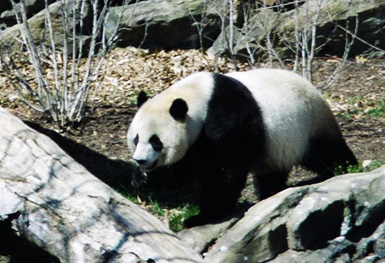 |
Tian Tian, one of the Zoo’s giant pandas, walks around the Fujifilm Giant Panda Habitat (Photo by Lauren Marshall). |
They are none other then the “celebrities” of the National Zoo, giant pandas Mei Xiang, Tian Tian and Tai Shan, and the “paparazzi” are some of the more than three million visitors to the Zoo each year, all of them clamoring for a glimpse of these stars.
Not only are the giant pandas extremely beloved and popular, but, in their newly renovated and expanded Fujifilm Giant Panda Habitat, they are the gateway species to Asia Trail—the first of several renovations taking place at the National Zoo through 2016.
“It [Asia Trail] represents a renewal process that’s going to be taking place over the next decade; the new master plan of the Zoo,” John Gibbons, public affairs specialist at the National Zoo, said.
| This sign describing giant pandas is one of many informational and interactive features found in Asia Trail (Photo by Lauren Marshall). | 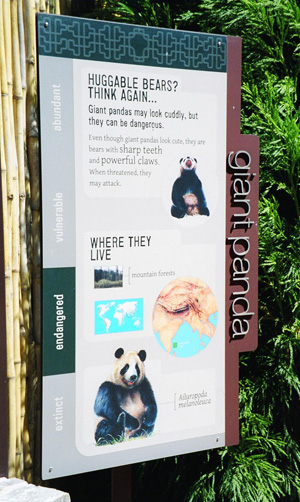 |
Having opened on Oct. 17, 2006, Asia Trail is a nearly six acre path, located directly within the zoo’s Connecticut Avenue entrance, along which the newly constructed and refurbished habitats of seven Asian species are housed.
The species chosen for this specialized section of the zoo include: sloth bears, clouded leopards, fishing cats, Asian small-clawed otters, red pandas and a Japanese giant salamander, all of which had custom made habitats built to meet their specific needs.
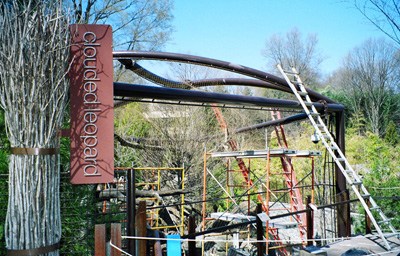 |
The clouded leopard habitat in Asia Trail is currently still under construction (Photo by Lauren Marshall). |
The final species in Asia Trail, the giant pandas, had their Fujifilm Giant Panda Habitat expanded both indoors and outdoors, with custom made additions such as rock grottos and waterfalls, to accommodate the animals’ likes and dislikes.
Both the Japanese giant salamander and the clouded leopard species are completely new to the Zoo, being placed on exhibit for the first time in the zoo’s 117-year history.
Each of the seven species was chosen for a specific reason.
| Merlin, one of the Zoo’s sloth bears, puts his hand over his eyes to block out the sun on a hot day (Photo by Lauren Marshall). | 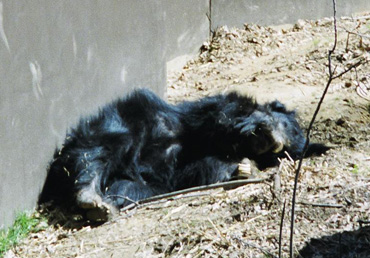 |
“We wanted species that illustrate not only a wide range of Asia, we have animals from India to Japan, the Himalayas and the tropics, but also the animals in which we are very involved with conservation efforts in the field,” Gibbons said.
Asia Trail is not merely just new animal habitats, but rather a venue to further the zoo’s objectives of conservation and education through the myriad interactive elements interspersed throughout each habitat, which are meant to educate and inspire zoo visitors.
“It [Asia Trial] is one of the premier areas of the zoo where not only animals are center stage, but also science and our conservation work is center stage,” Gibbons said. “So unlike the zoo exhibits of yesterday when you would walk up to an exhibit, read the animal’s name, see where it comes from in the world and move on to the next exhibit, this exhibit not only tells you what the animal’s name is and where it comes from in the world, but it tells you some of the hurdles it’s facing in the wild, what its status is in the wild, whether it is endangered, threatened, vulnerable and also what we are doing as scientists at the Smithsonian’s National Zoo to save that animal.”
One way that conservation is placed center stage throughout Asia Trail is at the several interactive touch screen kiosks. At these “Decision Stations,” visitors can explore the intricate conservation issues facing a species and even send the information they read to an e-mail address.
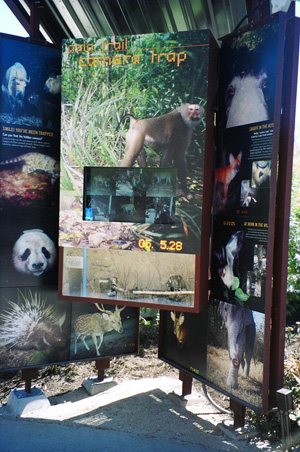 |
This camera trap interactive screen displays real images of animals found in the wild, alongside images of visitors taken at the Zoo next to the fishing cat habitat, in order to teach visitors about this conservation tool (Photo by Lauren Marshall). |
Many of the elements placed in the renovated habitats also serve to enhance visitor education.
At the sloth bear habitat, artificial termite mounds are placed throughout the exhibit to display how these furry creatures depend on their enormous sucking ability to suck the termites out and eat them when in the wild.
These fabricated termite mounds were created so that, during demonstrations and animal keeper talks, visitors can learn about and witness first hand the sloth bears’ sucking ability and how they act in the wild.
Gibbons explained just how this interactivity impacts the visitor.
“You see this gigantic bear who lives primarily on miniscule insects and when you read that or someone tells you about that you kind of get an idea and it is kind of interesting, but when you come to the zoo and you actually see it happen, that creates a memory, and that creates an impression,” Gibbons said. “And hopefully out of the 2,000 people that may see that demo every week, there will be four or five people where that impression will evolve into an interest or a passion or an action, like becoming a biologist or making a contribution to sloth bear conservation.”
| Hana and Balawat are the National Zoo’s sloth bear mother-son duo (Photo courtesy of the Smithsonian’s National Zoo). | 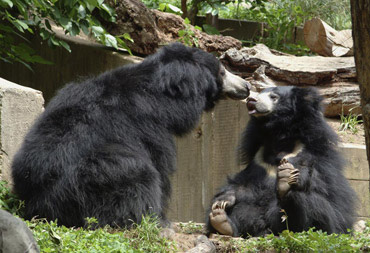 |
Gibbons continued to stress how important visitor involvement and interactivity is at the zoo.
“It is the idea of bringing the visitor into the experience versus letting them just walk around and soak up what they do and hope that the visitor gets it,” he said. “We get them excited about being here.”
Jenny Spotten is an animal keeper at the zoo and works with all of the animals on Asia Trail, except the giant pandas and the Japanese giant salamander.
She explained how the sloth bears have reacted to the new interactive aspects of their habitat, saying that they “settled right in, sitting in front of the glass and interacting with the people, especially little kids.”
Although the clouded leopard habitat is still under construction, when it is completed, visitors will have a close up view of these rare creatures because of the placement of a fabricated tree located near the visitors with selected electronically warmed branches to entice them to rest in viewing sight.
Other visitor-friendly features can be found at the red panda habitat, as Gibbons explained.
“There is lots of interaction for the visitors to figure out different things about them, such as ‘What does a red panda feel like?’ and then you can feel an actual pelt,” he said.
Another example of the education process taking place in Asia Trail is the very inclusion of the Japanese giant salamander, as Gibbons commented that most people do not “even know that there is such a thing as a giant salamander.”
 |
Mei Xiang, the Zoo’s female giant panda, relaxes comfortably in the shade (Photo by Lauren Marshall). |
He went on to describe the six-foot long, 80-pound creature as “one of the oddest things a visitor will ever see.”
The location of the Japanese giant salamander habitat being directly next to the giant panda outdoor habitat was also done with the idea of educating visitors about conservation in mind.
“You move from one of the cutest animals ever, the giant panda, to what most would consider ugly, but both are struggling through the very same thing…to survive in the wild,” Gibbons said. “We need to move away from thinking we should save the cute things first to thinking that they are all important, and all need to be saved.”
Jilian Fazio is another animal keeper at the zoo that works with all of the animals on Asia Trail, except the giant pandas and the Japanese giant salamander.
She commented on visitors’ reactions to Asia Trail since its opening to the public, saying that “people who have been here in the past are really impressed and happy with the renovations at the zoo.”
One such returning visitor is Antoinette Pajor, known as Tai Shan’s “surrogate mommy” to her friends and family because of her love for the nearly two-year-old giant panda cub.
Coming from Connecticut, this was Pajor’s first visit to the zoo since the opening of Asia Trail, and described it as “very interesting.”
| Jilian Fazio, an animal keeper, works with the Asian small-clawed otters during a demonstration, rewarding each animal with a treat when they complete their task correctly (Photo by Lauren Marshall). | 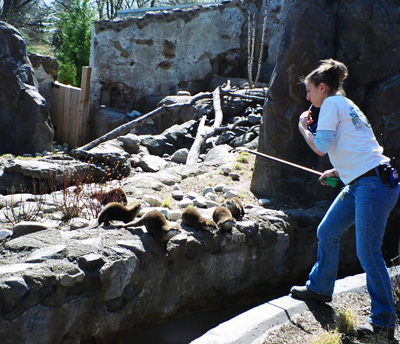 |
Pajor also commented on the interactive information stations placed throughout Asia Trail.
“I think the new type of information sites where you pull out the information is very good and they are at different levels for big people and little people,” she said.
Pajor’s entire trip to Washington, D.C., centered on seeing the giant pandas, which have a completely new renovated and expanded home in the Fujifilm Giant Panda Habitat.
Again, like so many of the other animal habitats in Asia Trail, elements in the Fujifilm Giant Panda Habitat were not only created with the giant pandas in mind, but also took the visitor experience into consideration.
For example, a cooling rock, which has water running under the rock surface to cool the animals in the warm weather, was placed merely an inch and a half away from the panel of glass that separates the animal from the visitor. This allows the visitor to come face to face with this majestic creature and experience the giant pandas in a much more personalized and exciting way which, according to Gibbons, “makes the experience that much better.”
“The visitor can experience some of the same things the animal is experiencing rather than just being told about it,” Gibbons said.
Visitor-friendly versions of several elements in the new giant panda outdoor habitat can be explored and experienced, including: being able to experience a fog cooling system, sitting in a grotto similar to the one used by the giant pandas and sitting on a cooling rock exactly like the giant pandas’ cooled rock.
A similar emphasis on conservation and education can also be found in the Fujifilm Giant Panda Habitat, with interactive stations describing the work of researchers in China and the conservation scientists at the zoo, “Decision Station” interactive kiosks and an example of a “fruitsicle,” one of the giant pandas’ favorite treats, just to name a few.
| The six Asian small-clawed otters found in Asia Trail are all brothers, and are quite popular with visitors (Photo by Lauren Marshall). | 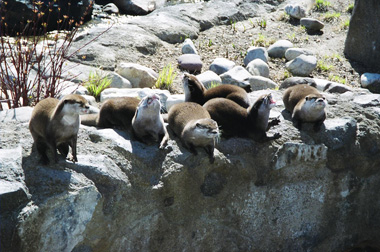 |
Visitors can also learn what a giant panda cub sounds like by pressing a button and listening to the cub’s high-pitched squeal while looking at a life-size model of what the tiny, hairless cub would look like.
Gibbons commented that the variety of the types of interactive elements, as to appeal to all the senses, was done so that the visitor can “become a part of the exhibit and experience it as a whole.”
At the Asian small-clawed otter exhibit, one of the largest in the United States, visitors can once again be educated by seeing the six brother otters in what would be similar to their natural habitat, which includes different levels of water and many trees.
Fazio explained that witnessing the otters interacting in their new habitat “demonstrates to the public what they really do in the wild,” which “makes a great impression on the visitor.”
Another way that the visitor is brought into the zoo experience can be found at the fishing cat habitat, where this sleek and cunning cat can be seen stalking her prey and sometimes even jumping into the water to get a “fishy” snack.
Specifically, the interactive activity found at the fishing cat habitat is a camera trap, an integral tool that the zoo uses all over the world as part of its conservation efforts.
Basically, the zoo will set up a camera trap in the wild and every time its laser is tripped, a photograph will be taken. This allows for the zoo to take a census of the animals in that area and also be alerted if there are any poachers.
So, while visitors are marveling in awe at the fishing cats, a camera trap is taking their photograph and placing it up on the camera trap interactive screen next to the habitat, unbeknownst to visitors.
Gibbons explained this clever interactive element, saying that, “you get trapped on a camera trap and it brings you into the experience. Now you are just like wildlife and your photo is interspersed with photos actually taken in the wild. It is immersing the public into the exhibit and making them want to learn more, not just telling someone something.”
It is in all of the many aforementioned ways that Asia Trail, as well as future renovations, serves to act as a classroom for the visitors, teaching them about the zoo’s conservation efforts by educating them about every aspect of every animal species.
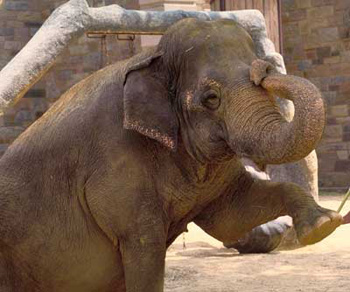 |
The Elephant Trails campaign includes the construction of a new and expanded habitat to accommodate a full matriarchal herd of Asian elephants and individual bulls (Photo courtesy of the Smithsonian’s National Zoo). |
The next step in the renovation process is Elephant Trails, the zoo’s multifaceted campaign to save Asian elephants, made up of four components that include: a brand new and expanded home for the elephants at the zoo’s Washington, D.C., campus; educational outreach; conservation science and a new elephant research facility at the zoo’s Front Royal, Va., campus.
The new Asian Elephant habitat, also known as Elephant Trails, will be a six-acre land event, expanding from the one and a half acres they have outdoors currently, including exercise trails for the animals, pools, sand piles, mud wallows and nearly five times the amount of indoor space that the elephants currently have.
Elephant Trails is a four-year construction process that begins in spring 2007 and, according to Gibbons, will be a “new dynamic addition to the zoo just as Asia Trail has been.”
Whatever the future brings for the National Zoo, there is no question that it will continue to be beloved by all who visit it.
Pajor summed it up best, saying that “it is a wonderful zoo, a real treasure.”
If You Go
The National Zoo is located at 3001 Connecticut Ave., NW, Washington, D.C., 20008. The main entrance to the zoo is on Connecticut Avenue, but there are additional entrances off Rock Creek Parkway and at the intersection of Harvard Street and Adams Mill Road.
For everything you want to know about the National Zoo, visit http://www.nationalzoo.si.edu. From web cams of the animals in their habitats to dates and times of daily talks and demonstrations, the zoo’s website has all the information you could ever want to know and more.
If you need directions on how to get to the National Zoo by Metrobus, Metrorail or car, visit http://nationalzoo.si.edu/Visit/GettingToZoo/.
The National Zoo is open every day of the year except Dec. 25 and admission is free. Hours change based on daylight savings time, with different hours for the general grounds and for the buildings, so check http://nationalzoo.si.edu/Visit/Hours/ before you go.
Parking at the National Zoo costs $4 for the first hour, $12 for two to three hours, and $16 for more than three hours, but is free for FONZ (“Friends of the National Zoo”) members. For more information about FONZ, visit http://nationalzoo.si.edu/JoinFONZ/Join/.
All zoo exhibits are wheelchair-accessible. However, it is important to note that the Zoo is located on hilly terrain in Rock Creek Park. Tours for visitors with hearing or visual impairment can be arranged on a Saturday or Sunday morning by calling 202-673-7800 (TTY) or 202-633-3025 (voice) at least four to six weeks in advance. For more information about disabled visitor access to the Zoo, call the FONZ Guest Services Office at 202-633-4480 or email rreichley@fonz.org.
There are snack stands located throughout the zoo, along with food concessions that include: Mane Restaurant on Lion/Tiger Hill, Panda Cafe near the Fujifilm Giant Panda Habitat, Express Grill at Panda Plaza and Popstop across from the Small Mammal House (seasonal).
For additional information about visiting the National Zoo, visit http://nationalzoo.si.edu/visit/.
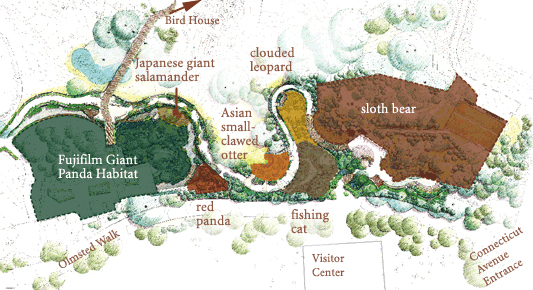
| A map of Asia Trail (Image courtesy of the Smithsonian’s National Zoo). |

Comments are Closed